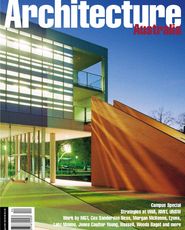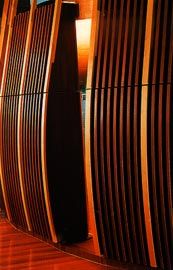
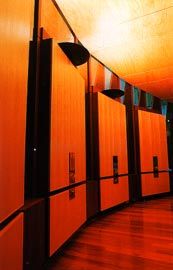
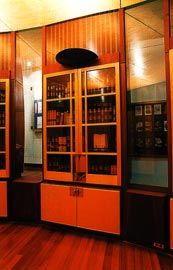
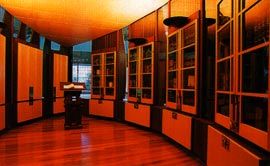
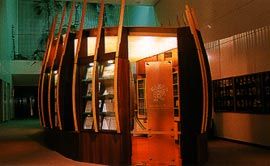
Photos David Sandison.
Many years ago, I attended an Australian Opera performance of Benjamin Britten’s “The Turn of the Screw”. The production design was particularly memorable for the over-scaled Chippendale armoires that shouldered the psychodrama; looming, bulging, homely/unhomely objects populating the stage with their mysterious insides – large enough to swallow Miles and Flora and to embody the governess’s fears. I often think of that production and the way it captured the psychological aspect of space-enclosing furniture: as habitable world, rich and secretive, preserving and protecting; within a room but distinct, possessing an interior landscape of secrets and surprises; an indivisible entity of inside and out.
Planet Design’s newly-fashioned space to hold and display the Queensland Supreme Court Library’s significant collection of rare books immediately invoked this quality for me. While not as spooky as the armoires of the opera stage, this room-sized cabinet-of-cabinets is similarly materially rich, spatially evocative, and formally allusive.
This little space has transformed the second level of the Supreme Court building.
Located at the end of a long wide gallery, lodged into the gentle ramp that takes people up and into the grand Banco Court, the making of the Rare Books Room gave Planet Design the opportunity to introduce the experience of another world – of the intimate contemplation of precious books, of special geometry, of lustrous material – into the stolid court foyer.
The plan geometry of the room was constrained by the need to maintain both the route into the Banco Court and visual and bodily access to the floor-to-ceiling picture window overlooking George Street at the end of the gallery. In seeking to accommodate the circulation, and to distinguish the intervention from the relentless orthogonality of the existing interior, some kind of curvature was inevitable. The resolved plan shape of a pointed ellipse, and the attendant three-dimensional articulation of a structure of bowed ribs and fins, is extraordinarily apt and adept. This little place of cabinets and shelves announces its presence with the prow poking into the indifferent gallery, then gently shoulders the movement of people up and around its bowed form.
From within, the resonance of the plan geometry as a “sacred” figure enhances the reverential quality of the elongated space, the edges of which are thickly, warmly and exquisitely drawn with jarrah, pine, bronze, and glass. The crafted cabinets, nested in the dark fins of the vessel, serve the dual nature of the room as place of conditioned storage and public display. Along one edge, they reveal treasured contents to the interior; and along the other they expose changing displays outwards to the space of the rising ramp.
The little structure offers all sorts of allusions to the imagination, from swelling cabinet(s) of curiosity, to something sort of ship-shaped, to the clawed setting of a jewel, to the bowed belly of a musical instrument. The courthouse community cheekily refer to it as “Aladin’s Lamp” and “Aladin’s Cave” – serendipitous characterisations that arise from the fact that the Supreme Court librarian is, indeed, named Aladin. It is this capacity for the little room to be so allusive that makes it really wonderful. Since the installation of the Rare Books Room, another room has been built at the opposite end of the second level gallery.
It is the replicated “Smoking Room” of the Queensland Government Steam Yacht Lucinda – an exact imitation of the space where Sir Samuel Griffith and his colleagues drafted significant portions of our constitution. The dumb theatrics of this replicated room amplify the imaginative force of the Rare Books Room, calling to our attention the potential of an accommodating play with allusion and ambiguity in the face of tradition.
Sheona Thomson is a lecturer in architecture at QUT.

